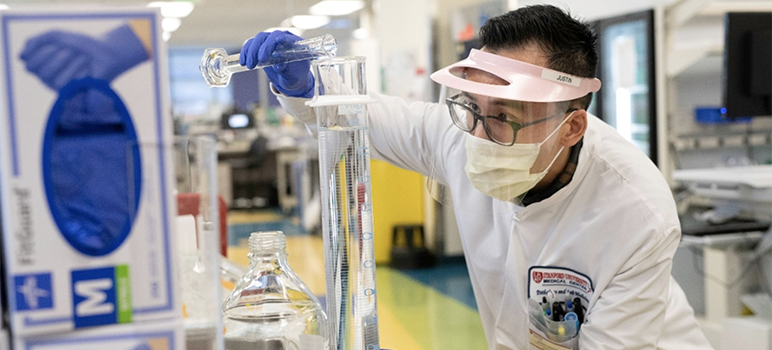The more people who get tested for Covid-19, the more accurately county health officials can track the spread of the virus.
Perhaps more important to the average citizen, the increase in testing means a better chance more businesses and activities can resume.
But it takes everyone to get out and be tested, and officials are trying to make it as convenient as possible.
“We offer numerous options for testing that are convenient for many schedules,” said Dr. Marty Fenstersheib, the county’s Covid-19 testing officer. “But we still have room for plenty more people—our capacity for pop-up, city-sites and drive-thrus is over 18,000 a day and we’re only using about 60 percent of that.”
A free, no-appointment-necessary testing site continues to operate at the South County Annex (formerly Antonio Del Buono Elementary), 9300 Wren Ave. in Gilroy, Sept. 29-Oct. 2 from 11am to 5:30pm. The site, operated by Valley Medical Center and Santa Clara County, has been operational since July 7.
While the site consistently reached its capacity of 1,000 tests a day early on, that number has dropped to 200-300 tests a day in recent weeks, according to Valley Medical Center registered nurse Pam Moore.
Health officials hope to raise those numbers once again, especially in an area such as Gilroy, which the county has classified as a region that has been disproportionately affected by Covid-19. According to county health data, Gilroy had 45 new cases between Sept. 22-27. Total cases since March are 1,532, giving the city a rate of 2,759 cases per 100,000 population, the second highest in the county next to the 95122 zip code in East San Jose.
Moore said the test involves a swab that is inserted about a half-inch to an inch in each nostril. It is much less invasive than the procedure during the beginning of the pandemic, where a six-inch swab was inserted in the cavity between the nose and the mouth.
That earlier procedure, Moore said, discouraged many from taking the test.
“Many people have said they are afraid of it because they’ve seen the videos,” she said. “They decided that it wasn’t for them.”
Kilani Louis, a disaster service worker for the county who is staffing the site, said the new testing procedure is painless.
“It’s super easy,” Louis said. “It doesn’t hurt. It really is quick and painless.”
The process takes only minutes to complete, according to Moore. People are given paperwork to fill out, which includes basic details such as name, address and demographic information. Insurance is not required to be tested.
If the site is busy, people will be given a wristband with a time to return.
Once the paperwork is completed, attendees will be guided to a registration booth, where staff will input their information into a computer. After that is finished, they will then receive the nasal swab by a nurse in personal protective equipment, which takes less than 15 seconds.
The testing results will be delivered by email within three days, with most being available by the next day, Moore said.
Santa Clara County moved into the less-restrictive “Red Tier” on Sept. 8 as part of California’s new Covid-19 reopening plan.
The state framework gives counties credit toward their case rate if they test more people than the state average. Using this calculation, the high number of tests performed in the local area gave Santa Clara County a significant credit, allowing it to move to the Red Tier.
Testing is free of charge, regardless of immigration status. For information, visit sccfreetest.org.
Experiencing the test
During my visit to the Covid-19 testing site at the South County Annex, I was invited to receive a test to experience the process first-hand.
I can attest that it is indeed fast, easy and most importantly, painless.
The paperwork and registration process was simple. Once that was complete, I was directed to an open swabbing booth. The test itself was nothing more than a slight tingle in my nose, and I was surprised by how quickly it took.
Every staff member that I encountered during the total five-minute process was friendly and knowledgeable.
My test result came back negative within 24 hours, giving me peace of mind that the safety precautions I have taken over the past six months continue to work.


What is the accuracy of the tests?
I’ve heard numerous reports of a high rate of false positives.
And what happens if the result of my test is a false positive?
Does that mean that the relentless “contact tracers” of the nanny state will be on my case, and that me and my community of contacts will be condemned to solitary confinement in quarantine?
I feel fine. I think I’ll pass on the “free” test.
First the appeal — “The more people who get tested for Covid-19, the more accurately county health officials can track the spread of the virus.”
Then the dangling carrot — “Perhaps more important to the average citizen, the increase in testing means a better chance more businesses and activities can resume.”
While the appeal may be arguably true, there is nonetheless an important question to be asked: How much more accuracy is needed? Almost 800,000 residents have been tested — huge by sample size standards — and it seems the positive rate has, for quite some time, been consistently at 3% or less (2.1% for last 7 days), suggesting the tracking has been accurate enough (under present conditions). Now, should conditions change, for instance, should the hospitals open up to those thousands awaiting examinations, lab tests, and surgeries, then accurate information about that distinct but small population can be factored into the overall statistics.
As to the carrot, there is no argument that country residents are champing at the bit to get back to living as free persons, but it is psychological blackmail to use that desire to justify restrictions that have declined from death prevention (flattening the curve) all the way down to fine-tuning the infection data.